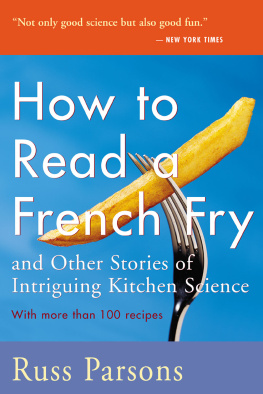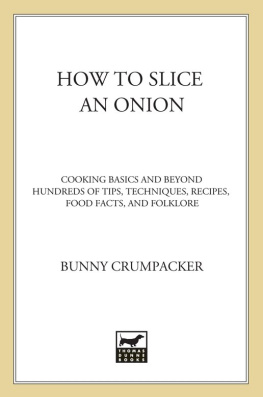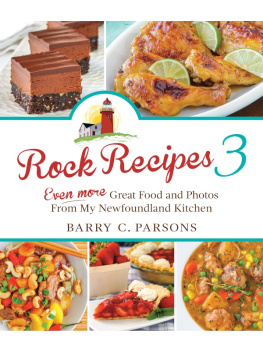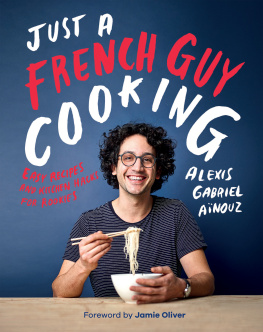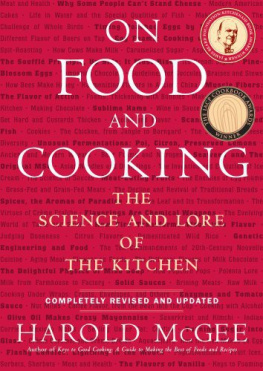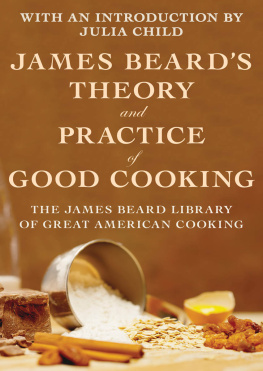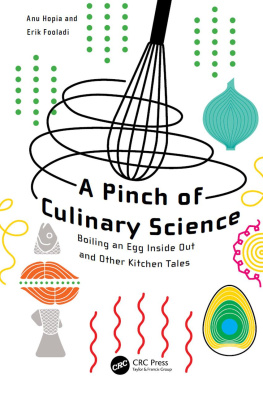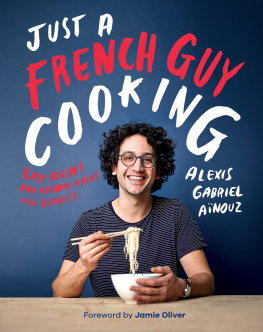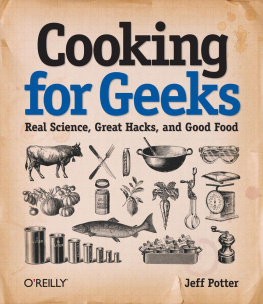Copyright 2001 by Russ Parsons
All rights reserved
For information about permission to reproduce selections from this book, write to or to Permissions, Houghton Mifflin Harcourt Publishing Company, 3 Park Avenue, 19th Floor, New York, New York 10016.
hmhbooks.com
Library of Congress Cataloging-in-Publication Data
Parsons, Russ.
How to read a french fry : and other stories of intriguing kitchen science / Russ Parsons.
p. cm.
ISBN 0-395-96783-X
ISBN 0-618-37943-6 (pbk.)
1. Cookery. I. Title.
TX651.P36 2001
641.5dc21 00-054685
Cover photograph by Jim Scherer
Author photograph by Anacleto Rapping
eISBN 978-0-547-34625-0
v1.0519
The author is grateful for permission to reprint the recipes in this book that originally appeared in the Los Angeles Times. Reprinted with permission of the Los Angeles Times, copyright 2000.
For my mom, who taught me to use words;
my dad, who taught me to think;
and Kathy and Sarah, who taught me almost everything else.
Acknowledgments
Being a journalist means never getting to say thank you. You work on a story, you talk to your sources, the story appears, and then you move on to the next one. Most of what we do as journalists is relay other peoples knowledge to our readers. And the only thanks we give is a brief mention in the newspaper. Ive got 25 years of thank-yous saved up.
The people whove helped me fall into three groups: cooks, writers and scientists. The first group, of course, is closest to my heart. Theyve fed me (come to think of it, so have many of the writers and one or two of the scientists too). People like Andre Diddy, Deborah Madison, Michel Mai, Rosa Rajkovic, Michael Roberts, Nadia Santini, Ken Shoemaker and Trudy Baker, Martha Rose Shulman, Nancy Silverton, Chris Smith, Zanne Stewart, C. B. Stubblefield and Clifford Wright have taught me much of what I know about the joys of cooking for other people. Special mention goes to the two truly brilliant cooks Ive known, Thomas Keller of the French Laundry in Yountville, California, and Michel Richard of Citronelle in Washington, D.C., my French brother.
A writer is a magpie, collecting bits and pieces of technique from everyone he reads. Another, less polite way of putting it is that we are a bunch of thieves, stealing anything that isnt nailed down. The people Ive robbed most happily include first and foremost Phyllis Richman and Matt Kramer, but also Toni Allegra, Michael Bauer, Rose Levy Beranbaum, Mark Bittman, Amanda Hesser, Charles Perry, Fred Plotkin, Bart Ripp, Jeffrey Steingarten, Sylvia Thompson and Paula Wolfert. And, of course, the queen mother of all food writers, Julia Child. Special mention must be made of the food staff at the Los Angeles Times, especially Ruth Reichl, who hired me in the first place and was by far the best boss Ive ever had in any capacity, and Donna Deane and Mayi Brady, who tested most of these recipes.
Then there are the scientists. Anyone who writes about the science of cooking owes a tremendous debt to Harold McGee, who opened our eyes to the subject. His On Food and Cooking remains an incredible achievement; everything that has been written since only makes it more remarkable. But there are also many other books on food science that are worth investigating. Two authors I find extremely valuable are Belle Lowe, whose books, though published in the 1930s, remain remarkably up to date in many ways, and Margaret McWilliams. In addition, I relied on the expertise of many, many people, both in print and in person. These include: P. J. Bechtel of Colorado State University; Eric Block of State University of New York-Albany; Michael Blumenthal of Rutgers University (who handed me practically everything I needed for the frying chapter and, indirectly, gave me the title for this book); Carlos Chrisosto of the University of California at Davis; Terry Dockerty of the Cattlemans Beef Association; Janet Eastridge of the Department of Agriculture; Ray Field of the University of Wyoming; Gregory Gray of the Department of Agriculture; Arthur Grosser of McGill University; Arthur Maurer of the University of Wisconsin; Nell Mondy of Cornell; Leslie Norris of McCormick and Company; Jay Novakofski of the University of Illinois-Urbana; Louis Rockland of Food Tech Research; Daryl Tatum of Colorado State University; and Alan Sams of Texas A&M. There are many more whose contributions to papers or journals were useful. Whether they knew it or not, they all contributed to this book. Of course, any faults lie with my misinterpretations, not with their information.
I owe a tremendous debt of gratitude to my stalwart agent, Judith Weber, who was always there when I needed her and contributed many good ideas (including spotting the title!), but always knew when not to ask me, Hows the book going? And finally, to the crew at Houghton Mifflin, especially my editor, Rux Martin, who never flinched when I asked to do just one more rewrite. That weve come through this process and remain on as good terms as when we started is a testament to our long friendship.
Recipes by Category
Appetizers and First Courses
Tuscan Potato Chips
Stuffed Zucchini Flowers
Fried Little Fish
Goat Cheese Tart with Caramelized Onions and Green Olives
Roasted Tomatoes with Goat Cheese
Trout Mousse
White Bean Crostini
Ceviche with Shrimp and Avocado
Dungeness Crab Coleslaw
Breakfast and Brunch
Cornmeal Waffles with Winter Fruit Compote
Strawberry Preserves
Nectarine and Rose Geranium Jam
Meyer Lemon Marmalade
Scrambled Eggs with Morels and Asparagus
Salads
Roasted Beet and Orange Salad
Celery Salad with Walnuts and Blue Cheese
Green Goddess Salad
Smoked Tuna Salad in Tomatoes
Seafood Rice Salad
Calamari Salad
Crisp Salmon Salad
Soups
Smoky Cream of Corn Soup
Cream of Cauliflower Soup
Squash Soup with Moroccan Spices
Fish Soup with Shellfish
Pasta, Rice and Beans
Orecchiette with Prosciutto and Peas
Pasta with Broccoli Rabe
Macaroni and Cheese with Green Onions and Ham
Broccoli Lasagna
Free-Form Lasagna of Roasted Asparagus
Wild Mushroom Lasagna
Pasta with Potatoes
Soft Polenta with Rag
Artichoke Risotto
Zucchini and Porcini Risotto
Pinto Bean Puree
White Bean and Swiss Chard Stew
Pinto Bean and Squash Stew
Pork and Beans... and Endive
Potato Gnocchi
Red Meat, Chicken and Fish
Crisp-Skinned Salmon on Creamy Leeks and Cabbage
Country Fried Chicken
Pan-Fried Chicken Breasts with Fresh Tomatoes, Green Olives and Rosemary
Pork Schnitzel with Arugula Salad
Ragout of Shrimp and Fava Beans
Braised Duck and Lentils
Sausages and Ribs with Red WineBraised Lentils
Salmon Braised with Leeks, Prosciutto and Mushrooms
Oven-Steamed Salmon with Cucumber Salad
Grilled Salmon with Chipotle-Tequila Butter
Grilled Swordfish with Salsa Verde
Baked Fish with Potatoes and Artichokes
Broiled Sand Dabs (or Sole) with Brown Butter
Roast Brined Turkey
Turkey Tonnato Sandwich
Real Fajitas
Umbrian-Style Pork Roast
Roast Lamb with Fresh Peas and Turnips
Chicken Braised with Green Olives and Thyme
Chicken in the Pot
Mushroom Pot Roast
Lamb and Lentils to Eat with a Spoon
Braised Lamb Shanks with Green Olives
Rag Napoletano
Wild Mushroom Meat Loaf
Spicy Garlic Sausages
Lamb, Orange Zest and Rosemary Sausages
Smokerless Smoked Bratwurst
Vegetables
Brussels Sprouts and Bacon

